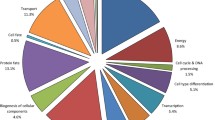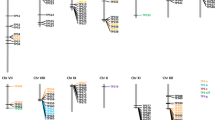Abstract
Three Kunitz trypsin inhibitor genes were isolated from trembling aspen (Populus tremuloides) by PCR and cDNA screening. Based on sequence similarity, they were grouped into two classes. Southern blots showed complex banding patterns and a high level of restriction fragment polymorphism between different aspen genotypes, suggesting that these trypsin inhibitors are members of a large, rapidly evolving gene family. One of the trypsin inhibitor genes, PtTI2, was over-expressed in Escherichia coli and its product shown to inhibit bovine trypsin in vitro. Both classes of PtTI genes are induced by wounding and herbivory, permitting rapid adaptive responses to herbivore pressure. The response appears to be mediated by an octadecanoid-based signaling pathway, as methyl jasmonate treatments induced the trypsin inhibitors. Wound-induced accumulation of trypsin inhibitor protein was also observed by western blot analysis. The pattern of expression, the apparent rapid evolution of TI genes, and the in vitro trypsin inhibitory activity are consistent with a role in herbivore defense. This work establishes the presence of a functional protein-based inducible defense system in trembling aspen.
Similar content being viewed by others
References
Agrawal, A.A. 1998. Induced responses to herbivory and increased plant performance. Science 279: 1201–1202.
Agrawal, A.A., Tuzun, S. and Bent, E. 1999. Induced Plant Defenses Against Herbivores and Pathogens. APS Press, St. Paul, MN.
Altschul, S.F., Madden, T.L., Schäffer, A.A., Zhang, J., Zhang, Z., Miller, W. and Lipman, D.J. 1997. Gapped BLAST and PSI-BLAST: a new generation of protein database search programs. Nucl. Acids Res. 25: 3389–3402.
Baldwin, I.T. 1998. Jasmonate-induced responses are costly but benefit plants under attack in native populations. Proc. Natl. Acad. Sci. USA 95: 8113–8118.
Bergey, D., Howe, G. and Ryan, C.A. 1996. Polypeptide signaling for plant defensive genes exhibits analogies to defense signaling in animals. Proc. Natl. Acad. Sci. USA 93: 12053–12058.
Bradford, M. 1976. A rapid and sensitive method for the quantitation of microgram quanitities of protein utilizing the principles of protein-dye binding. Anal. Biochem. 71: 248–254.
Bradshaw, H.D. Jr., Hollick, J.B., Parsons, T.J., Clarke, H.R.G. and Gordon, M.P. 1989. Systemically wound-responsive genes in poplar trees encode proteins similar to sweet potato sporamins and legume Kunitz trypsin inhibitors. Plant Mol. Biol. 14: 51–59.
Brenner, E.D., Lambert, K.N., Kaloshian, I. and Williamson, V.M. 1998. Characterization of LeMir, a root-knot nematode-induced gene in tomato with an encoded product secreted from the root. Plant Physiol. 118: 237–247.
Broadway, R. M. 1995. Are insects resistant to plant proteinase inhibitors? J. Insect Physiol. 41: 107–116.
Broadway, R.M. and Duffey, S.S. 1986. Plant proteinase inhibitors: mechanism of action and effect on the growth and digestive physiology of larval Heliothis zea and Spodoptera exigua. J. Insect Physiol. 32: 827–833.
Chang, S., Puryear, J. and Cairney, J. 1993. A simple and efficient method for isolating RNA from pine trees. Plant Mol. Biol. Rep. 11: 113–116.
Clausen, T., Reichardt, P., Bryant, J., Werner, R., Post, K. and Frisby, K. 1989. Chemical model for short-term induction in quaking aspen (Populus tremuloides) foliage against herbivores. J. Chem. Ecol. 15: 2335–2346.
Coley, P.D. 1980. Effects of leaf age and plant life history patterns on herbivory. Nature 284: 545–546.
Constabel, C.P. 1999. A survey of herbivore-inducible defensive proteins and phytochemicals. In: A.A. Agrawal, S. Tuzun and E. Bent (Eds.) Induced Plant Defenses Against Herbivores and Pathogens, APS Press, St.Paul, MN, pp. 137–166.
Constabel, C.P., Bergey, D. and Ryan, C.A. 1995. Systemin activates synthesis of wound-inducible tomato leaf polyphenol oxidase via the octadecanoid defense signaling pathway. Proc. Natl. Acad. Sci. USA 92: 407–411.
Constabel, C.P., Yip, L., Patton, J.J. and Christopher, M.E. 2000. Polyphenol oxidase from hybrid poplar. Cloning and expression in response to wounding and herbivory. Plant Physiol. 124: 285–295.
Doyle, J.J and Doyle, J.L. 1990. Isolation of plant DNA from fresh tissue. BRL Focus 12: 13–15.
Duffey, S.S. and Felton, G.W. 1991. Enzymatic antinutritive defenses of the tomato plant against insects. In: P.A. Hedin (Ed.) Naturally Occurring Pest Bioregulators, ACS Press, Washington, D.C., pp. 167–197.
Farmer, E.E. and Ryan, C.A. 1992. Octadecanoid precursors of jasmonic acid activate the synthesis of wound-inducible proteinase inhibitors. Plant Cell 4: 129–134.
Gill, S.C. and von Hippel, P.H. 1989. Calculation of protein extinction coefficients from amino acid sequence data. Anal. Biochem. 182: 319–326.
Green, T. and Ryan, C.A. 1972. Wound-induced proteinase inhibitor in plant leaves: a possible defense mechanism against insects. Science 175: 776–777.
Harborne, J.B. 1993. Introduction to Ecological Biochemistry. Academic Press, London.
Harlow, E. and Lane D. 1988. Antibodies: A Laboratory Manual. Cold Spring Harbor Laboratory Press, Plainview, NY.
Haruta, M., Pedersen, J.A., and Constabel, C.P. (2001) Trembling aspen (Populus tremuloides) polyphenol oxidase: cDNA cloning, defense-related expression, and identification of a potential sub-strate. Physiologia Plantarum (in press).
Hattori, T., Nakagawa, T., Maeshima, M., Nakamura, K. and Ashai, T. 1985. Molecular cloning and nucleotide sequence of cDNA for sporamin, the major soluble protein of sweet potato tuberous roots. Plant Mol. Biol. 5: 313–320.
Haukioja, E. 1980. On the role of plant defences in the fluctuation of herbivore populations. Oikos 35: 202–213.
Havill, N.P. and Raffa, K.F. 1999. Effects of elicitation treatment and genotypic variation on induced resistance in Populus:impacts on gypsy moth (Lepidoptera: Lymantriidae) development and feeding behavior. Oecologia 120: 295–303.
Heitz, T., Geoffroy, P., Fritig, B. and Legrand, M. 1999. The PR-6 family: proteinase inhibitors in plant-microbe and plant-insect interactions. In: S.K. Datta and S. Muthukrishan (Eds.) Pathogenesis-Related Proteins in Plants, CRC Press, Boca Raton, FL, pp. 131–155.
Hollick, J. and Gordon, M. 1993. A poplar tree proteinase inhibitor-like gene promoter is responsive to wounding in transgenic tobacco. Plant Mol. Biol. 22: 561–572.
Jongsma, M., Bakker, P., Peters, J., Bosch, D. and Stiekema, W. 1995. Adaptation of Spodoptera exigua larvae to plant proteinase inhibitors by induction of gut proteinase activity insensitive to inhibition. Proc. Natl. Acad. Sci. USA 92: 8041–8045.
Karrer, E.E., Beachy, R.N. and Holt, C.A. 1998. Cloning of tobacco genes that elicit the hypersensitive response. Plant Mol. Biol. 36: 681–690.
Lee, S.I., Lee, S.H., Koo, J.C., Chun,-H.J., Lim, C.O., Mun, J.H., Song, Y.H. and Cho, M.J. 1999. Soybean Kunitz trypsin inhibitor (SKTI) confers resistance to the brown planthopper (Nilaparvata lugens Stal) in transgenic rice. Mol. Breed. 5: 1–9.
Lindroth, R.L., Hsia, M.T.S. and Scriber, J.M. 1988. Chemical ecology of the tiger swallowtail: mediation of host use by phenolic glycosides. Ecology 69: 814–822.
Lindroth, R.L. and Hwang, S.-Y. 1996. Diversity, redundancy, and multiplicity in chemical defense systems of aspen. In: J.T Romeo, J.A. Saunders and P. Barbosa (Eds.) Phytochemical Diversity and Redundancy in Ecological Interactions, Plenum Press, New York, pp. 25–56.
Lindroth, R.L. and Kinney, K.K. 1998. Consequences of enriched atmospheric CO2 and defoliation for foliar chemistry and gypsy moth performance. J. Chem. Ecol. 24: 1677–1695.
Marchuk, D., Drumm, M., Saulino, A. and Collins, F.S. 1991. Construction of T-vectors, a rapid and general system for direct cloning of unmodified PCR products. Nucl. Acids Res. 19: 1154.
Orozco-Cardenas, M., McGurl, B. and Ryan, C.A. 1993. Expression of an antisense prosystemin gene in tomato plants reduces resistance toward Manduca sexta larvae. Proc. Natl. Acad. Sci. USA 90: 8273–8276.
Parry, D., Spence, J.R. and Volney, W.J.A. 1998. Budbreak phenology and natural enemies mediate survival of first-instar forest tent caterpillar (Lepidoptera: Lasiocampidae). Envir. Entomol. 27: 1368–1374.
Parsons, T., Bradshaw, H. Jr. and Gordon, M. 1989. Systemic accumulation of specific mRNAs in response to wounding in poplar trees. Proc. Natl. Acad. Sci. USA 86: 7895–7899.
Peterson, E.B. and Peterson, N.M. 1992. Ecology, Management, and Use of Aspen and Balsam Poplar in the Prairie Provinces. Forestry Canada Northwest Region Special Report No. 1.
Richardson, M. 1991. Seed storage proteins: the enzyme inhibitors. Meth. Plant Biochem. 5: 259–305.
Richter, T.E. and Ronald, P.C. 2000. The evolution of disease resistance genes. Plant Mol. Biol. 42: 195–204.
Ryan, C.A. 1990. Protease inhibitors in plants: genes for improving defenses against insects and pathogens. Annu. Rev. Phytopath. 28: 425–449.
Saarikoski, P., Clapham, D. and von Arnold, S. 1996. A wound-inducible gene from Salix viminalis coding for a trypsin inhibitor. Plant Mol. Biol. 31: 465–478.
Sambrook, J., Fritsch, E.F. and Maniatis, T. 1989. Molecular Cloning: A Laboratory Manual, 2nd ed. Cold Spring Harbor Press, Plainview, N.Y.
Schuler, T.H., Poppy, G.M., Kerry, B.R. and Denholm, I. 1998. Insect-resistant transgenic plants. Trends Biotechnol. 16: 168–175.
Spencer, M.E. and Hodge, R. 1991. Cloning and sequencing of the cDNA encoding the major albumin of Theobroma cacao. Identification of the protein as a member of the Kunitz protease inhibitor family. Planta 183: 528–535.
Wann, S.R. and Einspahr, D.W. 1986. Reliable plantlet formation from seedling explants of Populus tremuloides (Michx.). Silv. Gen. 35: 19–24.
Weiler, E.W. 1997. Octadecanoid mediated signal transduction in higher plants. Naturwissenschaften 84: 340–349.
Wishart, D.S., Stothard, P. and van Domselaar, G.H. 2000. Pep-Tool and GeneTool: platform-independent tools for biological sequence analysis. Meth. Mol. Biol. 132: 93–113.
Worthington, C.C. 1988. Worthington Enzyme Manual. Worthington Biochemical Corporation, Freehold, NJ, p. 346.
Yeh, F.C., Chong, D.K.X. and Yang, R.C. 1995. RAPD variation within and among natural populations of trembling aspen (Populus tremuloides Michx. from Alberta. J. Hered. 86: 454–460.
Yeh, K., Chen, J., Lin, M., Chen, Y. and Lin, C. 1997. Functional activity of sporamin from sweet potato (Ipomoea batatas Lam.): a tuber storage protein with trypsin inhibitory activity. Plant Mol. Biol. 33: 565–570.
Author information
Authors and Affiliations
Rights and permissions
About this article
Cite this article
Haruta, M., Major, I.T., Christopher, M.E. et al. A Kunitz trypsin inhibitor gene family from trembling aspen (Populus tremuloides Michx.): cloning, functional expression, and induction by wounding and herbivory. Plant Mol Biol 46, 347–359 (2001). https://doi.org/10.1023/A:1010654711619
Issue Date:
DOI: https://doi.org/10.1023/A:1010654711619




